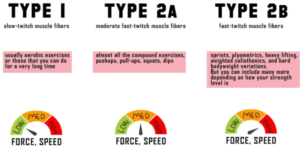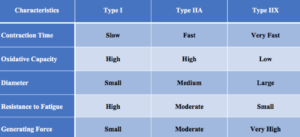The Role of Muscle Fibers in Running Distance
3 main types of muscle fibers comprise all the muscle tissue on our skeletons. These three fibers are categorized as slow twitch (oxidative), fast twitch (fast oxidative), and a hybrid of both (fast glycolytic). The hybrid fiber has more in common with fast twitch than slow so we will lump those two together. So essentially, we have fibers responsible for our fast and explosive movements.
Fiber Types and Energy Systems
We have fibers responsible for our steady state, long duration, and low power output movements. Each muscle in our body is a mixture of these two types of fibers. What makes a fiber different is the energy system. That feeds that type of fiber (hence the scientific names of oxidative or glycolytic). We will dive into these fibers, their differing energy systems, and how they affect our running performance.

Understanding Muscle Composition and Training Impact
Different muscle groups have different ratios of slow to fast twitch fibers. Think of your calf (gastrocnemius) vs. your pectoralis major and minor. These muscles have different responsibilities and perform in different ways. Therefore, they typically have a different ratio of fibers. Nonetheless, all muscles in the body contain a mixture of all 3 types of fibers. Another factor that plays into our ratio of fibers and how developed they are is how we train (or how we use our muscles in daily activities).
The Fiber Connection to Your Lifestyle
If you are on your feet all day at work, you better believe your body has adapted to maximize the use of slow twitch fibers in your leg muscles versus someone who plays basketball and sprints. Also, if you are a distance runner or walker, your ratio of muscle fibers will vary from that of a track sprinter or powerlifter.
The Secrets of Slow and Fast Twitch Dynamic
The things that make a slow twitch fiber slow and a fast twitch fiber fast are the energy system used (fuel), contractile speed, and recovery/ fatigue rate. Fast twitch fibers (Type IIA and Type IIx in the chart below) are typically anaerobic, meaning they can contract without oxygen. They contract at a very quick and forceful rate. But that comes with a trade-off: they can only function for a short time (this is why you cannot sprint a long distance without tiring and slowing down). Slow twitch fibers are aerobic (they need constant oxygen to fire) but fire at a lower force rate and can contract for an exceptionally long time without needing time to rest or slowing the pace. They are very fatigue-resistant.

Role of Muscle Fibers in Distance Running
At first glance, we would be inclined to think that distance running is simply a product of our slow twitch muscle fibers. After all, we do not sprint a distance event. But the reality is that our body operates in all three energy systems and uses all three muscle fibers simultaneously. The body blends all three without us even knowing. We are never using one set of fibers or one energy system; we are just using one system more than the others at specific intensities.
Strive for Balance
Therefore, distance runners must embrace all three fiber types and work to develop them all. By engaging in strength training, you enhance your slow-twitch muscle fibers for endurance and strengthen the fast-twitch fibers, boosting overall muscle performance. Seek guidance from the best trainer in Albion to tailor a comprehensive training program that addresses all aspects of your running journey.
Optimizing Performance OF Muscular Precision in Your Athletic Event
So, how do I tailor my training to target specific fibers and get the best carry-over into my athletic event? Train specifically for your event, but do not be afraid to incorporate some power and speed endurance into your training schedule. Runners can still participate in some weight training without fear of bulking up or losing their endurance.
Integrating Power and Strength Training
A skilled trainer can work in some power and strength training without causing harmful effects to your running gate. Remember, even the most dedicated distance runners do not work with just one fiber type or energy system. Train the complete muscular profile for the best results. The Smart Strength Growth team is always ready to help you in your fitness journey. “works smarter, not harder.”
Alex Harris
![]()



